Module Overview
You might have a target behavior in mind that you want to change. The success of any treatment plan hinges upon our dedication and strong desire to make the change. Without this, we will either fail at the plan or relapse in the future. To help us figure out how willing we are to make the change we will discuss the pros and cons of changing or staying the same and self-efficacy. Additionally, we will explore the effect of our values and mindset on change and how all four factors affect our willingness to make change.
Module Outline
- 3.1. Thinking About Changing
- 3.2. Pros and Cons of Making Change
- 3.3. Self-Efficacy
- 3.4. Values and Mindset
- 3.5. The Interrelationship of All Factors on a Willingness to Change
Module Learning Outcomes
- Clarify stages people go through when deciding to bring about behavior change.
- State the utility of a pros and cons analysis.
- Clarify the role of self-efficacy in behavior change.
- Clarify the role of values and mindset in behavior change.
3.1. Thinking About Changing
Section Learning Objectives
- Explain Prochaska et al.’s (1995) process of change.
Prochaska, Norcross, and DiClemente (1995), in their book, Changing for Good, state that “Change is unavoidable, part of life. Few changes are under our control. But some things we can intentionally change.” Knowing when to change is key because if you are not ready, you will inevitably fail. Likewise, if you spend too much time trying to understand your problem you might put off change indefinitely. Change unfolds through a series of six stages and successful self-changers follow the same road for each problem they desire to modify. These stages include: precontemplation, contemplation, preparation, action, maintenance, and termination. Let’s look closely at each.
3.1.1. Precontemplation Stage
This is when the person is not considering making a change and even resists the idea. Control of the problem is shifted to outside the person and they do not want to be nagged about the problem from family and friends. The individual even denies responsibility for the problem and justifies the behavior.
Prochaska, Norcross, and DiClemente (1995) suggest the individual answer the following questions to help them see the difference between problem behaviors and lifestyle choices:
-
- Do you discuss your behavior pattern?
- Are you well informed about your behavior?
- Are you willing to take responsibility for the consequence of your behavior?
Individuals move out of the precontemplative stage when they realize that their environment no longer supports their unhealthy lifestyle, when there is social pressure to make the change, or they receive direct requests from others such as employers.
3.1.2. Contemplation Stage
This is when change is seriously considered, but within a vague timeframe of the next six months. Many people stay stuck in this stage for a long period of time due to a fear of failure and so they postpone and procrastinate. We have made the decision to change, but only “when the time is right.” (Of course, we all know there is no such time.) We also engage in wishful thinking and desire to live as we always have but with different consequences such as eating what we want and not gaining any additional weight.
The authors state that you know you are ready to move on when your focus is on the solution and not the problem. We need to engage in consciousness-raising by asking the right questions such as understanding how many calories we really need to consume each day or what the effects of smoking are on the body and how long it will take to recover from them, if we can at all. We might also set goals, collect data, and do a functional assessment. In any case, it is critical to engage in this task during the contemplation stage as it helps us to be more aware of our problem behavior, understand how our thoughts and feelings maintain it, and start to really believe in the importance of changing it (Prochaska, Norcross, and DiClemente, 1995).
You can even engage in a process of self-reevaluation, which if successful, will show that your fundamental values are in conflict with the problem behavior. We might assess how unhappy we are with the habit or behavior in the present, and then engage in an appraisal of our happier, healthier changed selves in the future. We could also think before we act especially with problems involving overeating, smoking, or drinking; create a new image of a changed you; and evaluate the pros and cons of changing, which we will discuss in Section 3.2.
3.1.3. Preparation Stage
This is when the person gets ready to change within the next month. Make your intention to change public and develop a firm, detailed plan for action. In terms of the plan, be specific about what steps you will take to solve the problem. Commitment involves a willingness to act and a “belief/faith in your ability to change” which we will discuss in Section 3.3. Engage in social support also at this time, even if you decide not to make your plan for change public.
3.1.4. Action Stage
Now fully committed to change, we enter the action stage. This requires a great deal of time, energy, and sacrifice; and we must be aware that the action stage is “not the first or last stop in the cycle of change.” The action stage lasts for months and involves being aware of potential pitfalls we may encounter. We discuss this in Module 11 in relation to temptations and mistakes.
It is during this stage we engage in the process of change called countering, or substituting a problem behavior with a healthy behavior. Of course, all we may do is substitute one problem behavior for another but to minimize that possibility, we could engage in active diversion by keeping busy or refocusing energy into an enjoyable, healthy, and incompatible activity. We might exercise, relax, counterthink by replacing troubling thoughts with more positive ones, or be assertive if others in your life are triggering the problem behavior. Though resisting temptation is an accomplishment, it is not reward enough, and so we need to be rewarded when we counter, exercise, relax, counterthink, or be assertive. Helping relationships are also important to make our success more likely. We will cover many strategies in Modules 6-9 so keep this discussion in the back of your mind until then.
3.1.5. Maintenance Stage
This is when change continues after the first goals have been achieved. To be successful, your change must last more than just a few days or months. It should last a lifetime. To be successful at maintenance Prochaska, Norcross, and DiClemente (1995) state that you should have long-term effort and a revised lifestyle. Relapse is a possibility if you are not strongly committed to your change.
How do you maintain your positive gains? Stay away from situations or environments that are tempting. Our former problems will still be attractive to us, especially in the case of addictive behaviors. What threatens us most are “social pressures, internal challenges, and special situations.” In terms of internal challenges, the authors state that these include overconfidence, daily temptation, and self-blame. Creating a new lifestyle is key too. If we are under a great deal of stress, exercise or practice relaxation techniques instead of engaging in our former behavior of comfort eating or drinking alcohol.
3.1.6. Termination Stage
This is when the ultimate goal has been achieved but relapse is still possible. Actually, Prochaska, Norcross, and DiClemente (1995) note that, “Recycle is probably a more accurate and compassionate term than relapses. Recycling gives us opportunities to learn.” How so? They note that people pass through the stages not in a linear fashion but more in a spiral. It may seem like we are not making progress, but the spiral is ever pushing upward. Also, few changers ever terminate the first time around unless they have professional help or a clear understanding of the process of change. The authors have several other key recommendations for avoiding relapse/recovery which we will cover in detail in Module 16.
See also: McConnaughy, DiClemente, Prochaska, and Velicer (1989) and Prochaska and DiClemente (1992)
So how do you know which stage you are in? Take a look at the following list and find the first statement that is true for you. This indicates which stage you are currently in.
- I solved my problem more than six months ago. (Maintenance stage)
- I have taken action on my problem within the past six months. (Action stage)
- I am intending to take action in the next month. (Preparation stage)
- I am intending to take action in the next six months. (Contemplation stage)
- I am not intending to take action in the next six months. (Precontemplation stage)
(Statements adapted from questions created by Prochaska, Norcross, and DiClemente (1995))
Now let’s discuss the stages of change Prochaska, Norcross, and DiClemente (1995) refer to on a deeper level. Of course, a slightly different framework will be used in this book, but as you will come to see, it largely reflects the process of change model these authors proposed over two decades ago.
3.2. Pros and Cons of Making Change
Section Learning Objectives
- Clarify the importance of weighing the pros and cons against one another.
- Apply pros and cons to your own attempt at behavior modification.
Thinking may come with the best of intentions but doing is what really counts. We know this as the cliché, “Actions speak louder than words.” So how might you get to the action period? One technique is to weigh the pros and cons of any decisions involving the target behavior.
First, start by discussing the pros and cons of not changing the behavior. If we continue doing things exactly as we have so far, what would happen? If our goal is to reduce a problem behavior, consider that we have engaged in the behavior (i.e. smoking, playing video games instead of studying, acting out) because it gives us some benefit. We will learn in Module 6 that these are called reinforcers and they continue the behavior. For our purposes now, they are the pros of not changing. But because they are a problem, they cause bad things to happen too. These are the cons. What if our goal is to increase a desirable behavior instead of decreasing a problem one? We do not engage in the desirable behavior because some other behavior is more attractive or we just have not motivated ourselves enough to do so. There are also cons for leaving the behavior as is and pros of changing it.
Once we have dealt with not changing the behavior, we need to move to the pros and cons of changing the behavior. This discussion should be addressed in a short-term, long-term fashion. In either case, good things (pros) will come from making the change but there are negatives ramifications as well (cons). Some of these will happen right away or in a very short term while others may take years to occur.
Use the following table when addressing your pros and cons. Notice that there are three spots under each category to list the pros or cons. You could conceivably list far more than three for some, but also less than three for others. It all depends on your target behavior. Do research. There is nothing wrong with finding reasons you might not be aware of for changing your behavior or the consequences of not changing.
Table 3.1. Pros and Cons of Not Changing and Changing Behavior
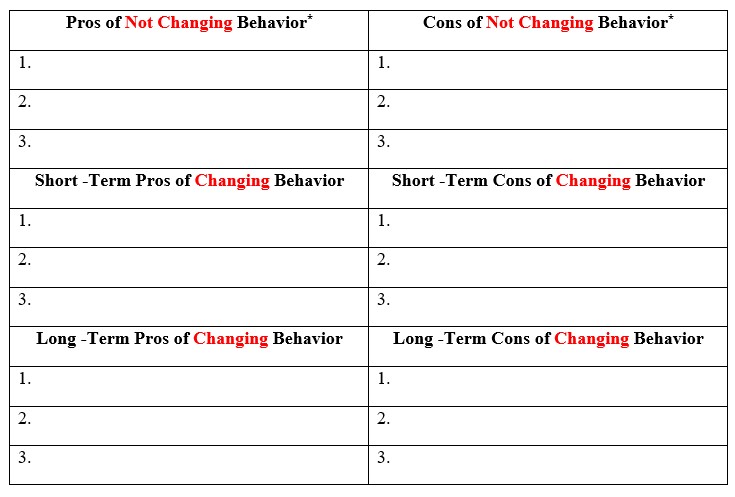
* To be clear, for not changing, you are asking yourself the following:
- Pros – What is good about keeping things as they are now?
- Cons – What is bad about keeping things as they are now?
Changing our behavior benefits us, but likely comes at a cost. The key question is whether the benefits outweigh the costs. So, it is a good idea to not only make your list, but to analyze it too. To do this, use the following three analyses:
- Weigh the pros of not changing against the cons of not changing. Ideally, the cons outweigh the pros opening the door for change. Be clear that you understand what this means. Consider the target behavior of adding exercise to your daily routine, which means you do not work out now or do so very little. The pros of not changing have you consider what the benefits of not working out are for you. The cons consider what is bad about not working out for you. The direction of analysis will look like the following:
Figure 3.1. Analysis 1 – Pros of Not Changing vs. the Cons of Not Changing Behavior
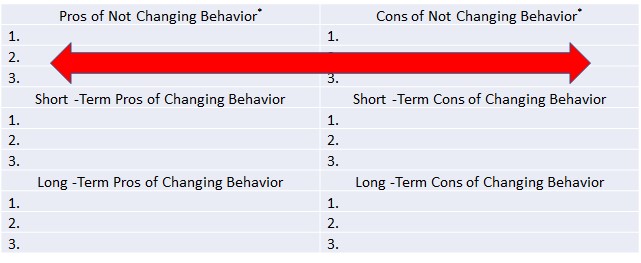
- Weigh the pros of not changing against the short and long-term pros of changing the behavior. Ideally, the pros of change win out. In our example, compare what is good about not working out versus what is good about working out. The direction of analysis will look like the following:
Figure 3.2. Analysis 2 – Pros of Not Changing vs. Pros of Changing Behavior
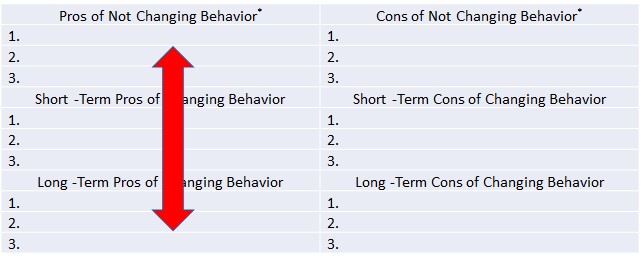
- Weigh the short and long-term pros of changing against the cons of changing. Again, the pros will hopefully win out. With our example, we are concerned about the benefits of working out versus the drawbacks of working out. The direction of analysis will look like the following:
Figure 3.3. Analysis 3 – Pros for Changing vs. Cons of Changing Behavior
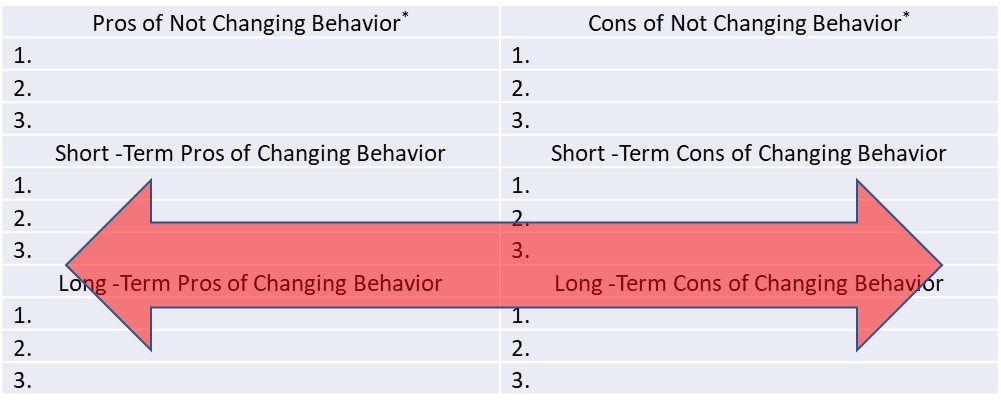
When doing the total analysis, one of three outcomes will occur. Use Table 3.2 to help you figure out which outcome is the correct one.
Table 3.2. Determining the Outcome of Your Total Analysis

- The cons of changing outweigh the pros of changing (Analysis 3) and/or the pros of not changing are greater than the pros of changing (Analysis 2) – In this case, you will remain in the precontemplative stage and not consider making any change.
- The pros and cons are even (for both not changing and changing; Analyses 1 and 3). In this case, you will likely stay in the precontemplative or contemplative stages. You might even flirt with the preparation stage.
- The pros of changing outweigh the cons of changing (Analysis 3) or the pros of not changing (Analysis 2) – In this case you might move to the action stage, and later maintenance and termination.
NOTE: It is important that you understand that this is not a mere numbers game. Having three items under pros and three under cons does not mean that the outcome of a particular analysis yields what is described in #2 above. Also, having 10 cons and 2 pros does not mean that cons win out. You should do the analyses and then interpret them so that you can weigh each of the pros and cons you come up with. It may be that the cons, though greater in number, are really minor points, and the smaller number of pros have much more merit and weight. As such, pros win out and cons lose (or cons win out over pros for the not changing analysis).
If this is still confusing for you, the following examples should help.
Example 1: Target Behavior – Running (Behavioral Deficit)
Exercise and its benefits seem obvious. Right? Exercise helps us with weight management, boosts energy, combats some diseases such as Alzheimer’s disease, builds our self-esteem, improves body image, makes our skin look better, and helps us recover from a major illness. But did you know that it also improves our mood, helps us manage stress, helps us sleep better, lifts depression, may make us age slower, can spark our sex life, and can be fun and help us to socialize with friends? Of course, exercise is not cheap if you choose to go to a gym or athletic club, but you can also exercise for free by just walking outside every day. So let’s examine the pros and cons of exercising more closely.
Table 3.3. Pros and Cons of Not Changing and Changing Running Behavior
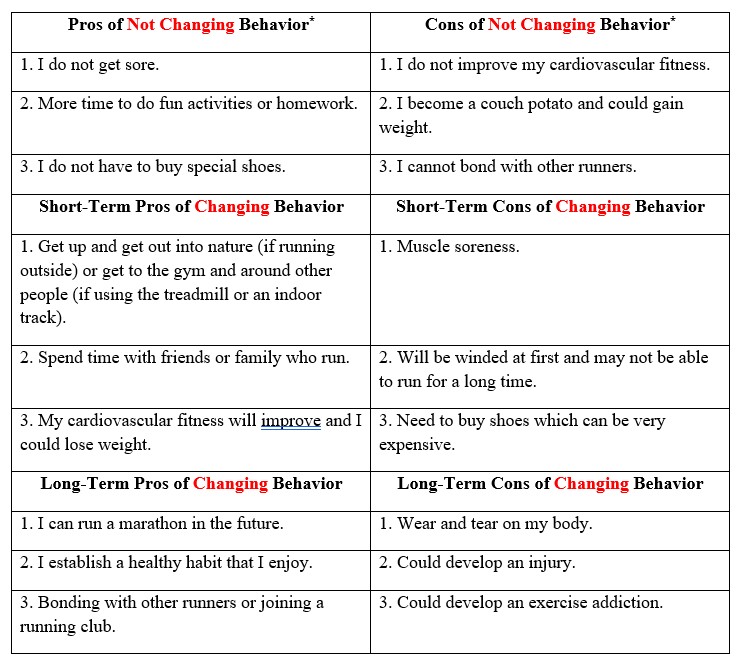
Analyses:
- 1 – Pros of not changing against the cons of not changing – I can save money on shoes and can stay limber, but of course, I am not getting in shape and losing unnecessary weight.
- 2 – Pros of not changing against the short and long-term pros of changing – Though I am not sore I will never be in shape and cannot take finishing a marathon off my bucket list. The time I spend running, which does take away from homework (or video games) is well-spent.
- 3 – Short and long-term pros of changing against the cons of changing – Though shoes do cost a lot, they will help me with correct posture and protect my feet and back when running. I also get to spend time with my significant other who loves to run. And my bestie does too. I just need to protect against injury and addictive behavior.
- Total – All-in-all, running is better than not running. How do we know this? Take a look at the table below and compare it to the outcome descriptions above.
Table 3.4. Determining the Outcome of Your Total Analysis – Running Behavior

Example 2: Target Behavior – Quitting Smoking (Behavioral Excess)
According to the Centers for Disease Control and Prevention (CDC), in 2011, nearly 7 in 10 adult cigarette smokers wanted to quit smoking and 42.7% made an attempt within the past year. The CDC also points out that in fiscal year 2017, states will collect an astounding $26.6 billion from tobacco taxes and legal settlements. Of this only $491.6 million, or less than 2%, will be spent on prevention and cessation programs. Only Alaska and North Dakota fund these programs at the CDC’s recommended level while Oklahoma provides only half the recommended funding. Connecticut and New Jersey provide no funding. They write, “Spending less than 13% (i.e., $3.3 billion) of the $26.6 billion would fund every state tobacco control program at CDC-recommended levels.” Each day, an estimated 3,200 minors (under the age of 18) smoke their first cigarette and 2,100 occasional youth and young adult smokers become daily smokers. What’s at risk? Smoking leads to cancer, heart disease, emphysema, tuberculosis, rheumatoid arthritis, lung diseases, diabetes, and chronic obstructive pulmonary disease (COPD). (Source: https://www.cdc.gov/tobacco/data_statistics/fact_sheets/fast_facts/). So there is a definite need for smokers to kick the habit. Let’s examine the pros and cons more closely.
Table 3.5. Pros and Cons of Not Changing and Changing Smoking Behavior
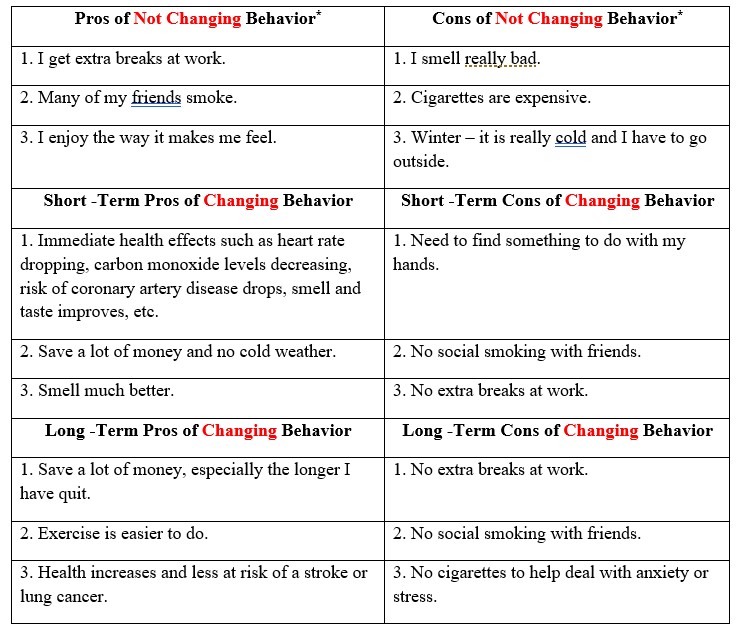
Analyses:
- 1 – Pros of not changing against the cons of not changing – The extra breaks and support from my friends is good, but my significant other does not like the way I smell and I always have to try and hide the scent with perfumes or body sprays. The cost of cigarettes is really tough since I am a college student.
- 2 – Pros of not changing against the pros of changing – Though I get some social benefits, I prefer to live a full life. And the treadmill kills me.
- 3 –Pros of changing against the cons of changing – Saving money, living longer, and smelling better definitely outweigh the trivial social benefits. And hey, there is always gum and stress balls to keep my mouth and hand busy.
- Total – All in all, quitting smoking is better than continuing to smoke. How do we know this? Take a look at the table below and compare it to the outcome descriptions above.
Table 3.6. Determining the Outcome of Your Total Analysis – Cigarette Smoking Behavior

Bear in mind, that even with all the right reasons, a person may still not engage in change. They might stay in the contemplation or preparation periods and not move to the action period. Also, the road to change is long and hard and the person will likely relapse along the way before making lasting change (Prochaska and DiClemente, 1992). This is why patience truly is a virtue and persistence is needed.
Prochaska, Norcross, and DiClemente (1995) state, “Preparation for change lies in the balance between your perception of the pros and cons of changing. In the precontemplation stage, you are likely to perceive the cons of changing as outweighing the pros. You will need to increase your pros of changing twice as much as you need to decrease the cons. The Processes of Change applied in the early stages have the greatest impact on the pros. The Processes of Change applied in the preparation and action stages have the greatest impact on the cons.” Think about what these last two sentences mean before moving on. Take a look at the information on the six states again if you need to.
3.3. Self-Efficacy
Section Learning Objectives
- Define self-efficacy.
- Contrast those high and low in self-efficacy.
- Clarify how self-efficacy affects the success of a behavior modification plan.
Change is not easy and the more change we have to make, the more difficult or stressful. This is where Albert Bandura’s concept of self-efficacy (Bandura, 1982, 1986, 1991a, 1991b) comes in.
Self-efficacy is our sense of self-esteem and competence and feeling like we can deal with life’s problems.
Self-efficacy includes our beliefs about our ability to complete a task and affects how we think, feel, and motivate ourselves. When our self-efficacy is high, we feel like we can cope with life events and overcome obstacles. Difficult tasks are seen as challenges and we set challenging goals. In contrast, if it is low, we feel hopeless, helpless, and that we cannot handle what life throws at us. We avoid difficult tasks and throw in the towel quickly when things get tough. These individuals are easily depressed and stressed.
Consider this in relation to how successful we might be with achieving our goal of changing an unwanted behavior or establishing a positive behavior. The pros and cons of changing the behavior, if weighing heavier on the side of making a change, give us the motivation or desire to make a change. But having the desire does not mean that change will occur. We must also have the ability, and possibly more importantly, we must believe we can make the change. The change itself is the obstacle to overcome and is challenging for us. If it was not, we would have made the change already. Those high in self-efficacy will be more likely to move from the action stage to maintenance and termination of the treatment plan compared to those low in self-efficacy.
An example will hopefully help you to understand the relationship between willingness and ability. In terms of losing weight, many people genuinely desire to shed unwanted pounds. So they have engaged in a pros and cons analysis and the pros won out. But many do not understand how to lose weight in terms of making sense of caloric intake, the impact of specific foods they eat, consumption of sugars and protein, the role of sleep and water intake, etc. Armed with this knowledge they can be successful. Their ability would match their desire to make change. But many do not know these important facts and so lose some weight early on but then stagnate and give up. Losing the pounds is motivational or reinforces the weight reduction behaviors being used, leading to continued commitment to the plan. But when weight loss stagnates, we become frustrated and return to the behaviors that caused the problem in the first place.
3.4. Values and Mindset
Section Learning Objectives
- Define values.
- Identify the values relevant to you.
- Explain how values affect your motivation to make change, your self-efficacy, and ultimately, your likelihood of success.
- Classify what growth and fixed mindsets are.
- Explain the effect of the different mindsets on self-efficacy and behavioral change.
Note to Student: To better understand this section, it is advised you use the Values and Mindset worksheet presented at the end of this module.
3.4.1. Values and Behavioral Change
Values have six main components that define them (Schwartz, 1992, 2005a). First, they are beliefs with emotional aspects. If a person is independent and can achieve it, they are happy. If their independence is threatened, they become highly vigilant, and if it is taken from them, they become upset. Second, values are not linked to specific actions or situations but define behavior in all situations. This is unlike norms which are particular to certain actions or situations. Third, they are linked to specific goals. Fourth, they are ordered meaning some values are promoted above others. Fifth, they are relative. In any given situation, more than one value is relevant. For instance, a religious person pursues conservation values at the expense of openness to change values such as Hedonism, Stimulation, and Self-Direction. Sixth, values are standards by which we can judge our behavior. If our behavior is consistent with our values, this process occurs subconscious but if it is not, it raises to conscious awareness. So, when taken together, a value is a (1) belief (2) pertaining to desirable end states or modes of conduct, that (3) transcends specific situations; (4) guides selection or evaluation of behavior, people, and events, and (5) is ordered by importance relative to other values to form a system of value priorities (Schwartz, 1994).
Values are incredibly important when we consider behavioral change. How so? Instead of telling you, I want to show you. Look at the Values and Mindset worksheet at the end of this module. Starting with Part 1, look at the list of values a human can subscribe to and determine which are Not Very, Very, or Utmost important to you. From the list of Utmost values, choose the three that are core values. State why these three are important. Then, consider how the various values you selected as Very or Utmost important may be more or less important in one of four domains of life – work/education, leisure, personal growth/health, and relationships.
Once you have finished with the values exercise, consider how values relate to your motivation to make change. Are there specific values that might make you successful at engaging in change? I bet the answer is yes, and when contemplating this, consider the values of Self-Control, Patience, Persistence, and Optimism. How might self-efficacy be affected? Again, identify specific values. Finally, consider how these values might lead to your success or failure.
3.4.2. Mindset and Behavioral Change
In her book, Mindset: The New Psychology of Success, psychologist Carol Dweck proposed that individuals have one of two mindsets: fixed or growth. Without my defining what these mean or you looking them up online, you should be able to figure them out pretty easily. Let’s see if you can. Take a look at Part 2: Mindset…and Behavioral Change. Take each of the descriptions above the table and place them under the category, either Growth or Fixed Mindset, where they would make sense going. I bet you will get them all correct.
Upon doing this, give some consideration to how growth and fixed mindsets relate to self-efficacy and behavioral change? Think about what you would do if you do not have all the skills you need to bring about behavioral change and you have a growth mindset? What about a fixed mindset? Which mindset would be most likely to lead you to obtain this needed skill/ability?
To learn more about mindset, please visit:
https://www.growthmindsetinstitute.org/2018/03/08/growth-and-fixed-mindset-definition/
3.4.3. Using What You Learned about Your Values and Mindset
Thinking about this now can lead you to develop strategies in your plan. Later, you will learn about cognitive behavior modification and a maladaptive cognition could be leading to a fixed mindset or you could hold a value inconsistent with change. Strategies such as cognitive restructuring, self-instructions, motivating operations, prompting, social support, or reinforcement in general could be used to compensate (not sure I would be as bold as to say correct) for a fixed mindset and place an emphasis on values conductive to change. Keep this in mind as you learn about the strategies later in this book and move to select the ones you will need in your plan.
3.5. The Interrelationship of All Factors on a Willingness to Change
Section Learning Objectives
- Hypothesize possible relationships between pros and cons, self-efficacy, values, and mindset.
- Propose solutions to issues that might arise.
To conclude this module, I thought it important to point out that all four factors discussed interrelate with one another. Consider that we may have the motivation to engage in change as shown by the pros and cons analysis and accounting for our core values, but not have the skills necessary to successfully make change such as if we want to weight train but are not sure which machines to use or how to use them. So, our self-efficacy is an issue and likely very low on the ten-point scale. If this is true, we could overcome the challenge if we have a growth mindset. But what if we have a fixed mindset? How might we gain those skills when we feel that giving up is easier to do? Or our values may not be consistent with wanting to learn these new skills such as if we do not place personal value in Curiosity. In this situation, motivation is good but self-efficacy is not.
It may also be the case that we have the skills and abilities we need, or we do not have the skills now, but do have the values conducive to learning them and have a growth mindset, and our motivation is low (as the pros and cons analysis showed). What do we do in this case? We could find ways to motivate ourselves and as you will see later, the token economy and establishing operations can help, as well as various types of reinforcers.
Determining where we stand on all four factors will allow us to plan for shortcomings wherever they exist. And don’t be deterred by shortcomings. They can be compensated for.
Values and Mindset Worksheet
Click here to access the Values and Mindset Worksheet in MS Word format – Values and Mindset Worksheet.
Click here to access the Values and Mindset Worksheet in PDF format – Values and Mindset Worksheet
Module Recap
In Module 3, we discussed a willingness to change from the perspective of DiClimente’s process of change and an analysis of the pros and cons of changing or staying the same. This was used to establish our motivation to make a change in our behavior. We also discussed self-efficacy and how believing in ourselves will make success more likely. This established our ability to make change. Of course, success is never guaranteed, and everyone makes mistakes or gives in to temptation. These lost battles do not mean the war is lost though. This relates to the values we hold most dear to us and their affect on our motivation to change. Equally important is whether we have a growth or fixed mindset, and its affect on our ability to acquire the necessary skills/abilities to bring about change. In all, this module highlighted the pros and cons of making change, self-efficacy, values, and mindset and their collective importance to bringing about behavioral change. Taking account of them all, and discovering where issues may lie, will help us to select strategies to overcome these challenges, or tap into our strengths.
In Module 4, we will continue our discussion of planning for change by taking our target behavior and giving it a precise definition. We will also discuss the importance of goal setting and challenges with doing so.
4th edition (4.10)
